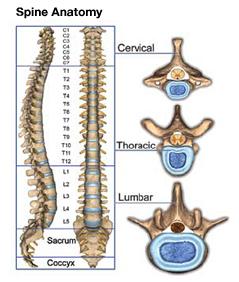Spondylolisthesis
 Description
Description
Spondylolisthesis is defined as a slip of one vertebral body relative to an adjacent vertebral body. This spinal condition most commonly
presents as a degenerative disease in adults but may be present in adolescents as a result of deformity or trauma.
Often there is mild to moderate back pain. If the slip is compressing a nerve, leg pain often develops.
Symptoms
A change in the position of the vertebra can lead
to back pain. Nerve compression may occur as
the condition worsens, resulting in leg pain.
- Lower back pain
- Leg pain and numbness may develop if there is nerve compression
Causes
Adults
- Arthritic changes
- Disc degeneration
- Pars defect
Adolescents
- Trauma due to athletic activities
- Congenital deformity
- Isthmic Spondylolisthesis
Possible Treatment Options
Non Operative Treatment
Medications, physical therapy or spinal cortisone injections are indicated for pain relief. Surgery can be considered for those who do not improve.
Decompression
This procedure involves removing all or a portion of the lamina, removing bone spurs and/or enlarging the foramen to relieve pressure on the nerve roots or spinal cord. This pressure is often the source of pain.
Posterolateral Fusion
Usually, in addition to a decompression, your surgeon will also perform an instrumented posterolateral fusion by inserting a series of rods and screws coupled with the placement of bone graft. This fusion provides increased spinal stability. Depending on the severity of the slip and degree of malalignment, the slipped vertebral body is sometimes pulled back to its original position using special instrumentation.
For more information on Spondylolisthesis, visit UnderstandSpineSurgery.com.
